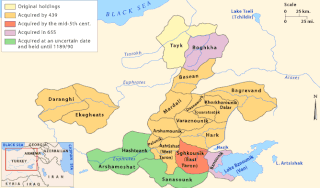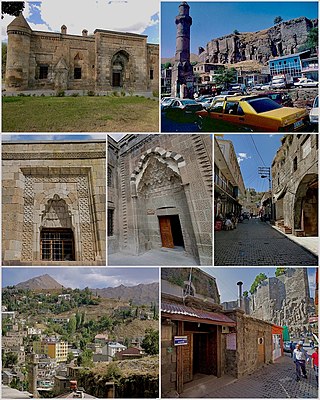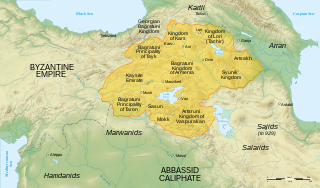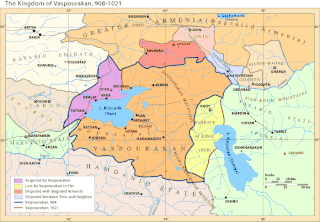
Year 602 (DCII) was a common year starting on Monday of the Julian calendar. The denomination 602 for this year has been used since the early medieval period, when the Anno Domini calendar era became the prevalent method in Europe for naming years.

The national coat of arms of Armenia was adopted on April 19, 1992, by resolution of the Armenian Supreme Council. On June 15, 2006, the Armenian Parliament passed the law on the state coat of arms of Armenia.

Isaac or Sahak of Armenia was the catholicos of the Armenian Church from c. 387 until c. 438. He is sometimes known as Isaac the Great or Sahak the Parthian in reference to his father's Parthian origin. He was the last Armenian patriarch who was directly descended from Gregory the Illuminator, who converted the Kingdom of Armenia to Christianity in the early fourth century and became the first head of the Armenian Church. He supported Mesrop Mashtots in the creation of the Armenian alphabet and personally participated in the translation of the Bible into Armenian.

Mamikonian, or Mamikonean, was an Armenian aristocratic dynasty which dominated Armenian politics between the 4th and 8th centuries. They were the most notable noble house in Early Christian Armenia after the ruling Arsacid dynasty and held the hereditary positions of sparapet and dayeak, allowing them to play the role of kingmaker for the later Armenian kings. They ruled over extensive territories, including the Armenian regions of Tayk, Taron, Sasun, and Bagrevand, among others. The Mamikonians had a reputation as supporters of the Roman Empire in Armenia against Sasanian Iran, although they also served as viceroys under Persian rule. Their influence over Armenian affairs began to decline at the end of the 6th century and suffered a final, decisive blow after a failed rebellion against Arab rule over Armenia in 774/75.

Taron was a canton of the Turuberan province of Greater Armenia, roughly corresponding to the Muş Province of modern Turkey.
The Armenian nobility was a class of persons which enjoyed certain privileges relative to other members of society under the laws and customs of various regimes of Armenia. Governments which recognized or conferred nobility were the Kingdom of Van, Satrapy of Armenia, Kingdom of Armenia, Bagratid Kingdom of Armenia (885–1045) and the Armenian Kingdom of Cilicia (1198–1375). The Armenian kingdoms of Vanand (963–1065), Syunik (987–1170), and Lori (978–1113) had a system of nobility that was similar to the nobility of Cilicia.

Bitlis is a city in southeastern Turkey. It is the seat of Bitlis District and Bitlis Province. Its population is 53,023 (2021). The city is located at an elevation of 1,545 metres, 15 km from Lake Van, in the steep-sided valley of the Bitlis River, a tributary of the Tigris. The local economy is mainly based on agricultural products which include fruits, grain and tobacco. Industry is fairly limited, and deals mainly with leatherworking, manufacture of tobacco products as well as weaving and dyeing of coarse cloth. Bitlis is connected to other urban centres by road, including Tatvan on Lake Van, 25 km to the northeast, and the cities of Muş (Mush), 100 km northwest, and Diyarbakır, 200 km to the west. The climate of Bitlis can be harsh, with long winters and heavy snowfalls. Since the local elections of March 2019, the Mayor of Bitlis is Nesrullah Tanğlay.

Muş is a city in eastern Turkey. It is the seat of Muş Province and Muş District. Its population is 120,699 (2022). Almost all of its population consists of Kurds.
John or Hovhan Mamikonyan was a 7th-century Armenian noble from the Mamikonian dynasty, author of the History of Taron, which is a continuation of the account of Zenob Glak. John is not known from any source other than his History, and in the colophon self-identifies as the 35th bishop of Glak after Zenob.
Medieval Armenia refers to the history of Armenia during the Middle Ages. It follows Ancient Armenia and covers a period of approximately eight centuries, beginning with the Muslim conquest of Armenia in the 7th century. Key events during this period includes the rebirth of an Armenian Kingdom under the Bagratid dynasty, followed by the arrival of the Seljuk Turks. During this period, a portion of the Armenian people migrate to Cilicia to seek refuge from invasions, while the remnants in Eastern Armenia see the establishment of Zakarid Armenia under the Kingdom of Georgia. This period also marks the emergence of the royal dynasty in Artsakh.
The Siuni or Siwni dynasty was an ancient Armenian princely dynasty which ruled the province of Siwnikʻ, with which the dynasty shared its name. They were one of the most important and powerful princely houses in antique and early medieval Armenia.

Stepanos Asoghik, also known as Stepanos Taronetsi, was an Armenian historian of the 10th-11th centuries.

Bagratid Armenia was an independent Armenian state established by Ashot I of the Bagratuni dynasty in the early 880s following nearly two centuries of foreign domination of Greater Armenia under Arab Umayyad and Abbasid rule. With each of the two contemporary powers in the region—the Abbasids and Byzantines—too preoccupied to concentrate their forces on subjugating the region, and with the dissipation of several of the Armenian nakharar noble families, Ashot succeeded in asserting himself as the leading figure of a movement to dislodge the Arabs from Armenia.

Surb Karapet Monastery of Mush was an Armenian Apostolic monastery in the historic province of Taron, about 30 km (19 mi) northwest of Mush (Muş), in present-day eastern Turkey.

Movses Khorenatsi was a prominent Armenian historian from late antiquity and the author of the History of the Armenians.

The Kingdom of Vaspurakan was a medieval Armenian kingdom centered on Lake Van, located in what is now eastern Turkey and northwestern Iran. It was named after Vaspurakan, a province of historic Greater Armenia. Ruled by the Artsruni dynasty, it competed and cooperated with the Bagratuni-ruled Kingdom of Armenia for a little over a century until its last king ceded the kingdom to the Byzantine Empire in 1021.

Arakelots Monastery was an Armenian monastery in the historic province of Taron, 11 km south-east of Mush (Muş), in present-day eastern Turkey. According to tradition, Gregory the Illuminator founded the monastery to house relics of several apostles. The monastery was, however, most likely built in the 11th century. During the 12th-13th centuries it was a major center of learning. In the following centuries it was expanded, destroyed and renovated. It remained one of the prominent monasteries of Turkish (Western) Armenia until the Armenian genocide of 1915, when it was attacked and subsequently abandoned. It remained standing until the 1960s when it was reportedly blown up. Today, ruins of the monastery are still visible.

The Bagratuni or Bagratid dynasty was an Armenian royal dynasty which ruled the medieval Kingdom of Armenia from c. 885 until 1045. Originating as vassals of the Kingdom of Armenia of antiquity, they rose to become the most prominent Armenian noble family during the period of Arab rule in Armenia, eventually establishing their own independent kingdom. Their domain included regions of Armenia such as Shirak, Bagrevand, Kogovit, Syunik, Lori, Vaspurakan, Vanand and Taron. Many historians, such as Cyril Toumanoff, Nicholas Adontz and Ronald Suny, consider them to be the progenitors of the Georgian royal Bagrationi dynasty.
Taronites, feminine form Taronitissa (Ταρωνίτισσα), was the name of a noble Byzantine family, descended from the ruling family of the Armenian principality of Taron. In Georgian it is rendered 'Tornikes' or ‘Tornikios’.
The Bagratuni family tree describes the heritage of the Bagratuni family in Armenia. Bagratuni lineage also lays claim to the Georgian Bagrationi dynasty.














